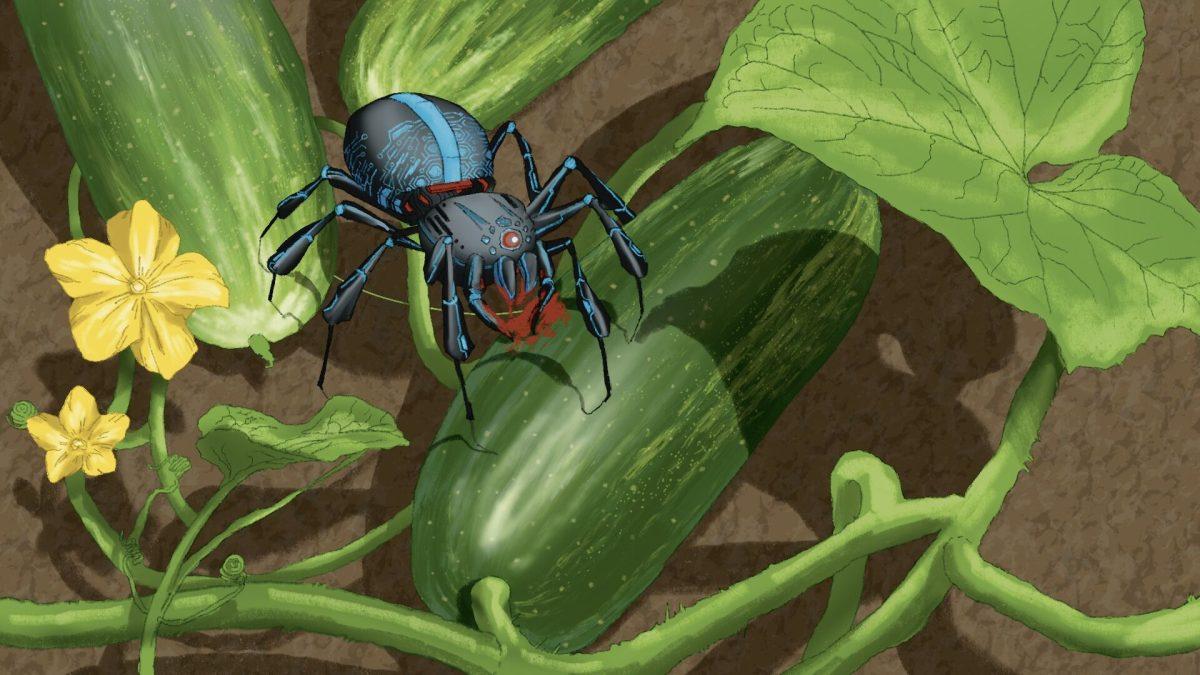Cucumbers, watermelons, squash and pumpkins. These are just a few of the cucurbit plants susceptible to downy mildew, a foliage disease of historical importance in the southeastern United States.
Lirong Xiang, assistant professor in the department of biological and agricultural engineering, and her teammates may have a solution.
Xiang’s research at NC State focuses on developing robotic platforms and machine technologies to automate tasks within agriculture that generally require hands-on labor.
When she came to NC State, Xiang joined Lina Quesada-Ocampo, professor and University scholar in the department of entomology and plant pathology, in researching and formulating a plan to tackle the downy mildew dilemma.
“The current practice to work with this downy mildew disease is that growers spray fungicides maybe every week or multiple times a month,” Xiang said. “So that’s a lot of time and money. And the way we reduce the labor cost [and] the chemical cost is to do precision spray instead of doing [a] broad spray for the whole field on a regular basis. … We were trying to develop a solution that can automate this process.”
Xiang hired Zhenghua Zhang, a PhD student in the department of biological and agricultural engineering, who has previous experience in mechanical design. As an undergraduate student at Xi’an Jiaotong University in China, Zhang built a six-legged ant robot designed to detect and extinguish fires.
Zhang said he wanted to study abroad in his graduate studies and sought opportunities for robotic design in the United States. He said he was eager to apply his expertise and knowledge to Xiang’s initiative.
“If I can make it possible, I think it will help farmers out a lot,” Zhang said. “It’s very meaningful.”
In contrast to the smaller ant robot he constructed, Zhang noted that controlling algorithms on a robot with 24 joints is complex, and additional challenges come with the fields’ terrain.
“There are many rocks, many grooves, so if the robot just has three joints, it cannot maintain a stable stage, and it always [gets] stuck in the grooves, so it cannot move anymore,” Zhang said.
However, this technology is more effective than previous robotic initiatives aimed at tending to farmers’ agricultural concerns. For example, aerial and wheeled robots have limitations, primarily due to their inability to get close to plants.
While there are obstacles that have yet to be overcome in using this technology, its future proves promising.
The benefits of using this technology goes beyond reducing labor and chemical costs for farmers, and it goes beyond the problem of downy mildew.
Xiang said they hope to utilize this technology with other agricultural practices such as weeding. Currently, farmers must use herbicide on the entire area — the plant, the weed and the soil — but this is an excessive and wasteful use of chemicals.
“If we use a robot to spray herbicides at the growth point of a weed, that can reduce up to 99.9% chemical use,” Xiang said. “This can really help with moving towards sustainable agriculture.”
This hexapod robot is an ongoing project, and Xiang, Zhang and other team members have high hopes for what it may become.
“In the future, we want to make our robots smarter and move more smoothly,” Xiang said. “We want to combine [it] with AI so that our robot can detect obstacles and the ground condition by the cells. I think the legged robot has great potential to adjust to some unique challenges in agriculture. … It is going to be our long term goal to have the system ready for all different various agriculture applications, such as weeding, sewing, disease detection, soil sampling, etc.”
The spider robot is currently operated using a joystick, but Xiang hopes that the robot will ultimately be fully autonomous and ready for farmers’ use on a larger scale. Additionally, she hopes they will be able to configure a group of legged robots to work together in the field to accomplish one goal or agricultural problem.
Thanks to start-up funding from NC State’s Plant Science Initiative and the Department of Biological and Agricultural Engineering, securing disclosure patents through NC State’s Office of Research Commercialization, collaboration with plant pathologist Quesada-Ocampo and the help of other PhD students like Weilong He, Xiang and Zhang have been able to create work that stands apart from other research entities.
“They [other researchers] use robots that can be purchased in the market [off-the-shelf], and they just change some mechanical design or revise the control algorithm, but we focus on the original research,” Zhang said. “We build our robot from scratch and [the] whole organism from zero.”
Other researchers, while producing valuable and meaningful work, are focused on wheeled or aerial robots that cannot access the plant in necessary ways. The legged robot, on the other hand, opens a window of possibilities.
“I think it could be the future of ultra-precision agriculture,” Xiang said.













